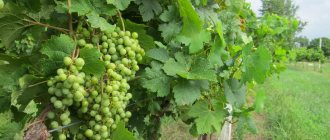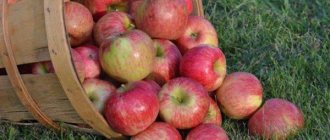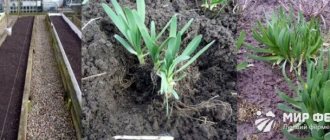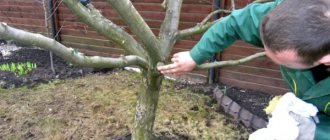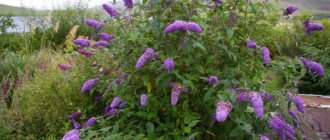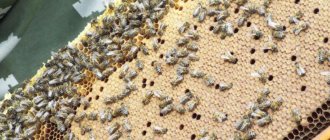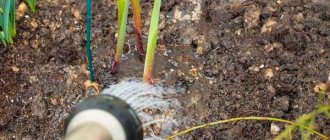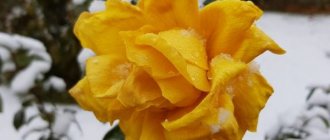When to think about shelter for apple trees
There really is no optimal timing. It all depends on the climate prevailing in the growing region, on the age and variety of apple trees, on weather conditions and much more. Experienced gardeners recommend starting the insulation process only after the average daily temperature outside is +9 °C or lower:
- If the procedure is carried out too early, this may lead to an increase in the length of the growing season. In addition, seedlings closed for winter too early may suddenly begin to grow rapidly in the fall, and this risks the fact that the trees simply will not have time to prepare for the onset of winter cold and will freeze, no matter how you cover them.
- If you insulate your apple trees too late (especially for seedlings and young trees), then you risk losing your trees. Their bark will be damaged and in the future they will not be able to grow normally, develop and produce a good harvest.
- In the southern regions of Russia, it is best to carry out insulation in early November. At this time, even the latest varieties of apple trees are already beginning to slowly go into a dormant state, the movement of juices in their tissues slows down. But you shouldn’t wrap the trunks too tightly in covering material.
- If the winter turns out to be mild, then the apple tree plantings will need not so much protection from frost as from attacks by rodents (in particular, mice).
Since most apple tree plantations are located in central Russia (in particular, in the Moscow region), plantings should be covered from the end of September to mid-October. In these regions, the average daily temperature can drop below +10 degrees much earlier than in the South, so all insulation procedures must be carried out in advance.
Important autumn procedures
Before covering an apple tree, you need to carry out preparations, which include some important procedures.
Watering
Autumn moisture-recharging irrigation is carried out after harvesting. Branches saturated with moisture become more elastic, strong and stable. This will guarantee that the shoots will not break off due to the heavy weight of the snow cover.
But crops do not always need to be watered. If autumn is wet and there is a lot of rain, then watering is not carried out. To check the need to add moisture, you need to dig 20 cm into the tree trunk circle and pay attention to the soil. When it is dry, you need to add water.
Watering rates are different and vary depending on the age of the apple tree. For young people, it is enough to add about 30 liters; for adults, this figure already reaches 60-70 liters. Tall apple trees need more water. Usually they check for a sufficient amount of moisture using a bayonet: the soil should be wet by 50 cm.
Digging and fertilizing
Before digging up the soil, you need to clean the tree trunk well. Use a pitchfork to remove all remaining vegetation and fallen leaves. You can dig with a shovel, but it’s better with a pitchfork. Do this carefully so as not to damage the roots of the plant. An important purpose of digging is to disturb pests that can settle in the tree trunk and find shelter there for the winter.
Applying fertilizer to the apple tree.
The apple tree needs to be fed 20-25 days before frost. This is exactly the amount of time needed for the nutrients to be absorbed. The ideal option would be to add organic matter. Humus or compost is poured under the tree; this is often done before digging or after harvesting it is applied with a rake. For an adult apple tree, 2 buckets are enough. You can add 50 grams of superphosphate and 30 grams of potassium chloride.
Whitewash
The trunk is whitewashed to protect the plants from frost damage and cracking of the trunks. The stem is not exposed to the sun and does not get burned.
Whitewashing also helps remove pests that overwinter under the bark. And what is important for young crops that grow in cold regions is that they are not damaged by rodents.
You need to cover the trunks with the solution up to the first fork of the skeletal shoots, catching them a little. Whitewashing should be done on a fine day, at a temperature higher than +3 degrees. You need to choose a warm day so that it doesn’t rain after whitewashing. A mixture of clay and lime is used, with copper sulfate added for better effect.
Removing branches
Sanitary pruning in the fall is necessary in any case. It is carried out in order to clear the crown of debris and old broken branches. You will need to remove those shoots that are diseased and withered, including healthy tissue.
Scheme for autumn pruning of apple trees.
The cut should be made with sharp pruning shears or garden shears to ensure even healing. A large area needs to be covered with garden varnish.
Pest protection
To remove pests, you need to carefully inspect the plant. You can often notice places where the bark is coming off. It is there that harmful insects hide and look for a secluded place for wintering.
In some cases, treatment against harmful insects is carried out in the fall. It is necessary to spray with pesticides if there was a massive accumulation of pests in the summer. In other cases, there is no need for additional spraying.
Irrigation
Some prefer to carry out the irrigation procedure in order to saturate the shoots of apple trees with moisture. This is usually done after harvesting in the southern regions and those where strong gusts of dry wind dry out all living things.
Rodent protection
To prevent the bark of plants, especially young ones, from being influenced by hungry mice and hares, it is wrapped with dense material. Some people prefer to scatter poison in a circle around the tree trunk to poison mice, but this method is not always rational and humane.
Wrapped bark on an apple tree.
Protection against rodents also involves the use of repellents. These could be ribbons stretched in the garden that make an unpleasant sound, or even commercial ultrasonic repellers.
Protection from diseases
To strengthen the immunity of the apple tree, you need to carry out the entire range of procedures. The plant will be maximally protected from diseases if it is reliably covered, fed and pruned.
How to cover apple trees for the winter
It is important not only to choose the right material, but also to treat it with various antiseptic compounds.
Suitable material options for covering apple trees:
- various rags;
- newspaper sheets;
- sackcloth;
- old stockings;
- plastic bags left over from sugar stocks, etc.
Before using old bags or used stockings, you need to clean them. They can be washed or soaked in a suitable cleaning product. If it is not recommended to wet the covering material, then it is necessary to treat it with a solution of copper sulfate or any other fungicidal preparation. This will help destroy all pathogenic microorganisms hidden in the layers of material.
Means for covering apple trees for the winter
- If apple trees are grown in too cold areas, then before laying covering materials it will be necessary to cover the surface layer with peat or straw. This will help prevent the tree trunk from freezing.
- Young plantings can be insulated with corn stalks, coniferous branches, reed stalks or the same straw.
- If you want to use only natural materials as insulation for apple tree plantings, then be sure to treat them not only with fungicidal compounds, but also with additional protective agents against rodents and other possible pests.
- Many gardeners believe that agrofibre is the best covering material. It, firstly, allows air masses to pass through, and secondly, retains heat. It does not need to be treated with any additional protective or disinfecting agents before laying. But if the tree was previously infected, then additional treatment with a suitable preparation will not hurt. The fence must be formed using a mesh made of metal or plastic.
Apple trees suitable for harsh climates
Severe frosts are rare in the Ural region. But even with severe frosting, trees adapted to the local climate manage to recover and produce a good harvest. For this purpose, zoned types of apple trees are grown in the Urals.
Ranetki
This species was obtained by crossing the Siberian berry apple tree and the Chinese tree. Instead of the latter, varieties of European selection were used for some hybrids. The fruits of ranetki are small. Usually their weight does not exceed 15 g. They are used for processing. The Siberian apple tree gave the ranetkas high frost resistance. Some varieties successfully withstand temperatures down to -50°C. For additional protection, such apple trees are grown as a low bush.
The best varieties of ranetki:
- The “Dolgo” variety produces small egg-shaped fruits of bright red color. It was obtained by American breeders, but the Siberian wild apple tree was taken as the basis. The taste of these apples is slightly sour and has a wine tint. The crown of the small tree is wide. The yield of the plant reaches 25 kg.
- The tree of the Sibiryachka variety has a compact crown. The plant has excellent winter hardiness. The weight of yellow fruits with a sweet and sour taste reaches 18 g. The crop, which ripens in August, is usually used for juice production.
On a note! In terms of concentration of biologically active substances, Ranetki exceeds European varieties several times.
Semi-cultured women
This type of apple tree, like ranetki, is grown in the form of a small bush. Their fruits are larger. But compared to ranetki, their winter hardiness is not as high. The best varieties include:
- “Silver Hoof” is a variety with a short ripening period and high winter hardiness. Its fruits are unusually large and tasty, reaching a weight of 100 g. They have a creamy-orange skin with a ruddy side. After planting a seedling, the plant produces its first harvest within 3 years.
- The “Dachnoe” variety also has large fruits, but ripens in the fall rather than in the summer. The fruits have a soft yellow skin with a small ruddy spot. The plant is resistant to many diseases.
Natural stones
This form was created artificially. The plants have normal winter hardiness, but the crown is adjacent to the ground. The height of such fruit trees when grafting is used does not exceed 2.7 m. The plants produce large fruits, the weight of which reaches 500 g. Despite the small size of the crown, the yield of the stale varieties is high. They are able to withstand temperatures down to -410°C. The best varieties of this species:
- Down to earth;
- Sayan of the dawn;
- Bratchud;
- Wonderful;
- Carpet.
How to prepare apple trees for the onset of winter frosts
Proper preparation of fruit trees for winter includes several important procedures that should be carried out sequentially:
- First of all, sanitary pruning of all plantings is carried out. Fallen leaves, cut branches, broken fruits and other debris should be collected and burned away from the main plantings.
- Then all trees are treated with a solution of copper sulfate or any other specialized fungicidal compounds that will prevent the development of fungi and the formation of lichens.
- At the same time, you need to paint the lower parts of the apple tree trunks using whitewash.
- Approximately 2-3 days before covering the plantings for winter (but before the onset of noticeable frosts), you need to thoroughly water the substrate under each apple tree.
Only after all of the above procedures can you begin to insulate the fruit plantings.
Climate Features
The Ural Mountains stretch from north to south and are very long. Therefore, the climate in this region varies greatly. In the north, in the subpolar and polar zones, winters are very cold, with frequent winds. The cold summer here lasts no more than 1-2 months.
In the center of the Ural region, the climate of the western and eastern parts is very different. In the east it is milder with snowy winters and moderate frosts. In the western part there are more dramatic changes. In summer it is dry and hot, and in winter there are severe frosts. Unstable weather prevails in the mountainous part. In the south it is very windy in the spring-summer season. In winter, there is a lot of snow here, and the temperature sometimes drops to -55°C.
Not all fruit trees survive in such a harsh climate. To prevent plants from freezing in the frosty winter, they need insulation. Without good shelter, they do not bear fruit and suffer from diseases and insect pests.
We insulate apple trees
The method of shelter will depend not only on the age of the apple tree, but also on its height. Very young plantings will require more thorough insulation, however, adult plants should not be deprived of attention. The process of forming shelter for columnar varieties also has its own nuances.
Insulation for young apple trees for the winter
Apple seedlings and young trees, especially first-year ones, need proper and careful shelter for the winter. Their increased sensitivity to low temperatures makes them vulnerable to winter cold:
- Find a fairly dry place in the garden that is protected from drafts.
- At the selected location, dig a recess, the depth of which should be approximately 50 cm and the width 35 cm.
- If the substrate is too loose, add a little humus into the groove.
- Soak the roots of apple tree seedlings in a clay mash, and then plant them in a dug hole, sprinkling the plant with a mixture of peat and humus on top.
- Lay a layer of selected agrofibre on top. Cover the entire area under the plantings with straw, and tie up the branches of the apple trees.
- Wrap the above-ground part of the seedling thoroughly with covering material, which you have previously treated with a disinfectant composition.
After a sufficient amount of snow has fallen, the place where the closed seedling is located needs to be heated with snow mass for additional protection from freezing.
How to cover mature trees for the winter
Adult apple trees are more resistant to low temperatures and any temperature changes, but this does not mean that they do not need protection from frost. For most regions of Russia, it is enough to cover the lower parts of trees (trunk and branches) with protective material. But if you grow apple trees in colder areas of the country, then you will need to take a more responsible approach to the issue of insulation:
- Place additional insulation between the covering material and the wood (usually peat mixture or straw).
- Insulate the root system of the tree and its lower part. To do this, pour a thick layer of peat or spruce mulch into the area under the tree.
- Do not forget to treat all materials with special disinfectants before use.
Shelter for columnar varieties of apple trees
These varieties of apple trees are especially vulnerable to frost, so they will need careful insulation and reliable shelter before the arrival of winter:
- Drive a pole next to the tree to be covered. It will serve as a support for the plant and will reduce the risk of trunk breakage in squally winds.
- Tie all the branches and shoots so that they fit tightly together.
- Then wrap the apple tree in several layers of burlap. Additionally, cover the tree with agrofibre, and also tie up the insulation so that it does not fall at the first gust of wind.
- Tie the tree to the pole you previously installed as a support.
Warming the trunk and roots
To cover the roots of plants, spruce branches are most often used. It is laid out in a circle near the trunk; some people lay roofing material or burlap on top so that the material fits more tightly and is not moved by the wind. After snow has fallen, you need to apply as much of it as possible in the tree trunk circle.
To insulate the trunk, you need to choose the appropriate material and use it correctly. If this:
- plastic bottles, then the neck and bottom are cut off, put on the barrel and secured. You need to make sure that they do not squeeze too much;
- using fabrics and burlap is ideal. These materials allow air to pass through well and maintain temperature well;
- the use of roofing felt or any non-woven material is possible, but with some restrictions. It needs to be removed as soon as it gets warmer, so as not to create a greenhouse effect;
- spruce branches, reeds or corn are tied to the trunk and secured.
Well-insulated apple tree.
You can often combine several options, for example, securing a cover made of spruce branches with film or agrofibre.
Young trees
It is especially important to monitor young trees, because they are most susceptible to cold weather. After all the above procedures, you can add one more answer to the question of how to prepare a young apple tree for winter: snow. When it falls out, you need to throw it as much as possible onto the crown and the ground in the tree trunk circle. Some even advise putting a little tops or brushwood on top so that the snow holds on tighter.
In the spring, after the snow melts, the shelter is removed. But it is important to take into account that if the barrel is wrapped in material that does not allow air to pass through, then it must be removed when the thaw has just begun. This applies to film and roofing felt.
Columnar apple trees
A feature of columnar varieties is ease of care and compactness. Because of the unusual shape of the column, this name appeared. They are closer to winter and more susceptible to cold. They also have a shallow root system, which suffers in cold winters without snow. If the top bud freezes, lateral shoots may appear, which will completely disrupt the idea of columnar apple trees and varieties.
In order to insulate a columnar apple tree as much as possible, you need to take a number of important steps:
- cover the space at the roots;
- wrap the barrel completely with warm material;
- You especially need to take care of covering the upper bud;
- if there is snow, then throw it in a heap for landing.
The same principles apply to young seedlings that do not yet have many branches.
Nuances of insulating apple trees for other regions
If everything is more or less clear with the middle zone and southern regions, then with the regions of the Urals or Siberia everything is somewhat more complicated:
- It is almost impossible to predict exactly what winter will be like in the Urals. Sometimes frosts in these areas can reach -40 degrees, so you need to take care of shelter for apple orchards already in mid-September. It is best to lay covering material in the form of a layer cake: one or more types of insulating raw materials are used, straw, peat mixture or manure (in the root zone) is poured on top of it to protect the plant from freezing in the ground.
- In most regions of Siberia, apple tree plantings are insulated in the same way as in the Urals, i.e. in early to mid-September. The trunk and branches are usually covered up to a level of 1.5 m. Peat mass or straw should be thrown over the area of the root system. After the snow falls, you need to heat up as thick a layer of snow mass as possible under the apple tree to additionally protect the roots and lower part of the tree from freezing.
Features in different regions
Depending on the region, the timing of the start of preparing crops for cold weather varies. But there are some other features that relate directly to the characteristics of the regions.
In the Urals and Siberia
A feature of these regions is the harsh winter and unfavorable conditions. If tall crops are grown in the Urals, then in Siberia they plant mostly crops that are formed in the form of stale. They are insulated, like any other, by wrapping the trunk. Apply as much snow as possible to the crown.
In outskirts of Moscow
In the Moscow region and surrounding areas, apple trees often suffer from strong gusts of wind in winter. Therefore, it is necessary to install supports near the young apple tree so that they are not broken. Otherwise, all insulation procedures are standard.
Installation of insulation with supports.
The appearance of frost holes on apple trees
This phenomenon is often encountered by those who have poorly prepared apple trees for wintering.
Most often, frostbites appear after a very frosty winter or a prolonged thaw. The defect looks like a depression that appears at the base of the shoots or on the trunk. Sudden temperature changes can also provoke the formation of frost holes. With such changes, the outer parts of the trunk begin to rapidly shrink, and the liquid coming out of the cells freezes, causing the wood to rupture. Trees begin to change color from white to brown or light brown, as they are no longer able to supply food to the shoots.
Inside the apple tree, peculiar vascular blockages form, which prevent the passage of nutrients to the young shoots. The food begins to mix with substances that clog the vascular channels or flows out of the resulting frost hole. Because of this, various pests begin to settle around the defect or infections develop.
To eliminate the possibility of such a problem, you should adhere to the following rules:
- choose only frost-resistant varieties that are suitable for growing in cold regions;
- carefully select the area for planting the apple tree (the place should not be damp);
- feed the soil;
- Closely monitor changes in the trees, and also cover the plantings well for the winter to avoid frostbite.
What you need to know about shelter technology
There are many ways to cover apple trees. They are based on the age and type of tree. Young trees in winter need the most reliable protection. The circle around the trunk must be covered with insulating material and covered with snow on top. It is necessary that the crowns are also covered with snow, sprinkle it periodically. To prevent the snowdrift under the trunk from being blown away by the wind, you can throw tops or small brushwood on top. Winter insulating material must be removed when the thaw begins. Mature trees older than 7 years should not be covered so diligently for the winter; their bark has already become thick and rough. It is enough to insulate the root collars and pour earth or mulch around the apple trees.
The insulation of columnar apple trees has its own specifics. This variety is distinguished by its dwarf growth, the absence of lateral branches and the location of the fruits along the trunk. Due to its size, this variety is especially susceptible to freezing. Under the influence of sub-zero temperatures, the apical bud gives rise to new branches, which then become independent trunks and disrupt the appearance of the tree, which looks like a column.
Attention!
To protect the columnar variety from freezing, you need to cover the entire crown along with the top.
